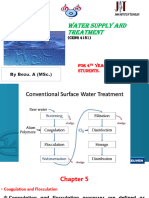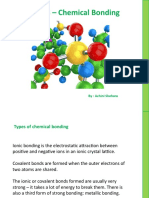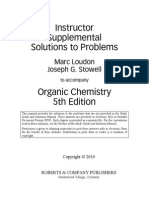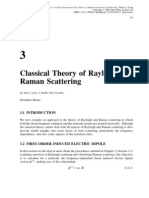0 ratings0% found this document useful (0 votes)
24 viewsFormation of Limonitic Jasper: True Solutions and Colloidal Solutions Distinguished
Formation of Limonitic Jasper: True Solutions and Colloidal Solutions Distinguished
Uploaded by
JonathanVladimirGiraldoCalcinaFormation of limonitic jasper occurs through two main processes: as cellular pseudomorphs and as massive jasper product. Experiments show that silica and iron are transported in groundwater either through true solution as ions or colloidal solution as particles too small to filter. Silica concentrations in rivers average around 10 parts per million and decrease farther from source. Calcium bicarbonate and peat solutions are most effective at dissolving silica from rocks. Sea water and calcium bicarbonate best precipitate low concentrations of silica as a gel.
Copyright:
© All Rights Reserved
Available Formats
Download as DOCX, PDF, TXT or read online from Scribd
Formation of Limonitic Jasper: True Solutions and Colloidal Solutions Distinguished
Formation of Limonitic Jasper: True Solutions and Colloidal Solutions Distinguished
Uploaded by
JonathanVladimirGiraldoCalcina0 ratings0% found this document useful (0 votes)
24 views4 pagesFormation of limonitic jasper occurs through two main processes: as cellular pseudomorphs and as massive jasper product. Experiments show that silica and iron are transported in groundwater either through true solution as ions or colloidal solution as particles too small to filter. Silica concentrations in rivers average around 10 parts per million and decrease farther from source. Calcium bicarbonate and peat solutions are most effective at dissolving silica from rocks. Sea water and calcium bicarbonate best precipitate low concentrations of silica as a gel.
Original Title
Chapter 4
Copyright
© © All Rights Reserved
Available Formats
DOCX, PDF, TXT or read online from Scribd
Share this document
Did you find this document useful?
Is this content inappropriate?
Formation of limonitic jasper occurs through two main processes: as cellular pseudomorphs and as massive jasper product. Experiments show that silica and iron are transported in groundwater either through true solution as ions or colloidal solution as particles too small to filter. Silica concentrations in rivers average around 10 parts per million and decrease farther from source. Calcium bicarbonate and peat solutions are most effective at dissolving silica from rocks. Sea water and calcium bicarbonate best precipitate low concentrations of silica as a gel.
Copyright:
© All Rights Reserved
Available Formats
Download as DOCX, PDF, TXT or read online from Scribd
Download as docx, pdf, or txt
0 ratings0% found this document useful (0 votes)
24 views4 pagesFormation of Limonitic Jasper: True Solutions and Colloidal Solutions Distinguished
Formation of Limonitic Jasper: True Solutions and Colloidal Solutions Distinguished
Uploaded by
JonathanVladimirGiraldoCalcinaFormation of limonitic jasper occurs through two main processes: as cellular pseudomorphs and as massive jasper product. Experiments show that silica and iron are transported in groundwater either through true solution as ions or colloidal solution as particles too small to filter. Silica concentrations in rivers average around 10 parts per million and decrease farther from source. Calcium bicarbonate and peat solutions are most effective at dissolving silica from rocks. Sea water and calcium bicarbonate best precipitate low concentrations of silica as a gel.
Copyright:
© All Rights Reserved
Available Formats
Download as DOCX, PDF, TXT or read online from Scribd
Download as docx, pdf, or txt
You are on page 1of 4
Chapter 4
FORMATION OF LIMONITIC JASPER
Limonitic jasper manifests itself in many types of supergene
iron oxide compounds, but is preeminent only in two: in cellular
pseudo morphs, and as massive jasper product. For the present,
pyrite will be the principal sulfide which will be involved in the
discussion of limonitic jasper, though other sulfides will be
mentioned incidentally.
A variety of massive limonitic jasper common in Precambrian
rocks is jaspilite, in which layers of jasper alternate with layers
of chert. Jasper is commonly reddish, but may be yellowish or
brownish. Considera- tion of jaspilites will be necessary in order
to obtain an understanding of cellular pseudomorphs.
In many cases silica has been precipitated as a gel, with iron
oxide dispersed through it in particles so small as to make the
product appear amorphous. In other cases both silica and the
limonitic particles crystallized out distinctly, but so minutely
that their crystal forms are recognizable only under high
magnification (see table 1, ch. 2). Because of the minute grain
size of the iron oxide particles within their glassy matrix, the
iron content in the hand specimen frequently has been over-
estimated, just as the percentage of coloring matter in glass, or
the percentage of ink in a glass of water, usually is
overestimated by the uninitiated. This proba- bly explains why
the cellular product was not differen- tiated for so long a time
from non-cellular limonite. In addition, the minute size of the
particles may make difficult the determination of its correct
content of iron by routine laboratory methods. The particles
frequently are less than 1 micron across. Ordinary pulverizing of
the sample therefore may not free or expose all the iron oxide
particles from the silica which surrounds them, and such
particles may fail to go into solution. More than one analyst has
registered complaints upon that score.
Among published papers, that by Moore and May- nard
(1929), although written for another purpose, has done probably
the most to clarify our conception of what limonitic jasper is,
and how it is formed as a supergene mineral. Their experiments
amplify and carry farther, in several important respects, the
earlier work of Lovering and other investigators.
The experiments by Moore and Maynard were con- ducted to
show the manner of solution, transportation, and precipitation of
silica and iron in ground water for areas of moderate to
extensive organic decay, essen- tially free of oxidizing sulfides.
Such water in many respects contrasts sharply with that
originating in min- ing districts of arid and semi-arid regions,
where gossans normally are best developed; but much of the
informa- tion derived from the experiments is applicable to arid
and semi-arid mining regions because many of the con- ditions
which govern solution, transportation, and precipitation of silica
and iron have universal application.
TRUE SOLUTIONS AND COLLOIDAL
SOLUTIONS DISTINGUISHED
Before considering the results of the Moore-Maynard
experiments in detail. it is important to understand the manner in
which the essential components of limonitic jaspersilica and
ferric oxide or ferric oxide hydrate may exist in ground water.
They exist in water either in true (molecular or ionic) solution, or
as colloids.
Colloidal particles represent aggregates of a limited number of
molecules. Though they are so small that they will be kept in
suspensin indefinitely by the Brownian movement. provided
further coalescence and the resulting agglomeration are
prevented, nonethe- less they are large enough to be caught and
retained by an animal membrane, parchment paper, or unglazed
porcelain filter when the liquid containing them is passed
through such a filter. The liquid, together with the colloidal
particles dispersed in it, is called a colloidal solution, or sol. The
words hydrosol, alcosal, etc. are used to indcate that the
dispersing liquid is water, alcohol, etc.
From the above descriptions it might be inferred that the only
differences between a true solution and a colloidal solution of
similar mineral composition is a matter of aggregation or group-
molecule size. Some chemists believe, for example, that all
dissolved silica (generally known as silicic acid) when freshly
derived from a silicate, is in true or molecular solution, but that
by aggregation of the molecules colloidal silica results
(Freundlich, 1926, p. 421).' Because both true solutions and
colloidal solutions of silica and ferric oxide
FORMATION OF LIMONITIC JASPER 17
minerals are nvolved in the formation of limonitic jasper, persons
engaged in leached outcrop interpre- tation should grasp firmly
the distinctions between the two.
A final point should be noted: although particles which pass
through or fail to pass through filters of the types specified
usually are spoken of. respectively, as being in true or in colloidal
solution, the filters conceiv- ably may have tiny holes in them too
small to be detected but nevertheless large enough to permit fine
colloids to pass through. On the other hand certain sub- stances
have single molecules many times larger than those of inorganic
origin. Under some conditions filters thus might fail to pass even
a single molecule of organic substances with giant molecules.
The procedure of filtration as above outlined thus can not
always be relied upon to furnish a sharp separa- tion between
what at present are referred to as true solutions and colloidal
solutions. It does however pro- vide a crude basis for such
separation.
THE SOLUTION, TRANSPORTATION, AND
PRECIPITATION OF SILICA AND IRON
Reverting now to the experimental work performed by Moore
and Maynard, partial results of the experiments, showing the
solution of silica and iron from rock silicates (norite and
diabaseigneous rocks) by dis- tilled and several types of ground
water, are set forth in table 3, chapter 5. The experiments and
other data supplied by them lead to the following conclusions
regarding the solution, transportation and precipitation of silica
and iron oxide.
Silica
1. The average silica content of the earth's river waters is
approximately 10 parts per million. The amount tends to diminish
as the rivers approach the sea. On the other hand, cise to the
source a content of 20 to 30 parts per million is not uncommon.
1
2. Under conditions embraced by the experiments
most complete investigations thus far carried out. checking his results by
practically every known method. In the last of a series of seven papers, which
summarizes the principal results he discussed what he believes were
fundamental errors in the work by Kahlenberg and Lincoln, and showed that
the reason the previous investigators found only or mainly colloids is because
they permitted the crystalloid silica to diffuse through the mem- brane and
discarded it, so that only the colloidal silica remained. He concluded from his
own work that in extremely dilute solutions of sodium silicate all of the silica is a
true solute, and that only as the solutions become more concentrated and the
Na30 : SiO. ratio increases beyond 1 : 2 are colloids developed signifi- cantly.
Despite Harmon's findings not all geologists and chemists regard the issue as
settled (see, for example, Hitchen, 1945).
The silica content of streams depends lipn the terrain over which they flow.
Invariably, the streams drainng granite and other igneous areas are higher in
silica than those draining sedi- mentary and glacial areas (Tarr, 1917, p. 427).
that is, in the abscnce of important sulfide oxidation to yield
mineral acidscalcium and magnesium bicarbonatos, and the
alkali bicarbonates. followed by peat (representative of decaying
organic matter) solutions, are the most effective solvents of silica.
3. When in true (molecular or ionic) solution, the silica in
natural waters is thought to be carried usually as silicates of the
alkalies, notably as sodium silicate. But in time the silica particles
gradually coaglate, and colloidal solutions result.
:
4. Silica in true solution as sodium silicate, accord- ing to
Harman (1927) in 1925-1927 made what probably are the
Moore-Maynard, when not exceeding 25 parts per million, is
precipitated most effectively by sea water and calcium
bicarbonate, followed much less effectively by potassium sulfate
and sodium chloride. The silica comes down as a gel. The
effectiveness of all electrolytes increases with concentration of
silica in solution, but at ordinary concentrations in natural water,
precipitation by any of them is a slow process, and rarely is
complete.
5. Silica hydrosols in dilute solution are precipitated most
effectively by sodium chloride at the concentration of sea water.
Calcium and magnesium bicarbonate, and other electrolytes are
on the whole neflicient.
6. At a concentration not exceeding 25 parts per million of
silica, magnesium sulfate acts as a stabilizer for silica in true
solution and as hydrosols. Above that concentration. and
especially when the silica content reaches several hundred parts
per million, excess magnesium sulfate precipitates the silica
rapidly from solution though not from hydrosols. The silica in this
case comes down not as a gel but as magnesium silicate, probably
as MgO.SiCX, with excess Si0
2
.
In regions such as those to which the Moore-May- nard
experiments are applicable, silica in ground water is thus present
mainly in small amounts. When fresh, the silica generally is in
true solution; but, given time, it usually agglomerates, and is
carried as a hydrosol. From a hydrosol it is precipitated
effectively only by sea water or sodium chloride. Under all except
very special conditions the silica precipitates from true or
colloidal solution as a gel. The process is a slow one, extending
over many months, and rarely goes to completion.
Iron
1. The averageiron content of the earths river waters
probably does not greatly exceed 1 or 2 parts per million, but
individual streams carry far more. The Amazon and its tributaries,
for example, carry 2 to 7 parts per million of ferric oxide; 8 to 10
parts per million frequently are present in regions where bog iron
deposits or swamps do not exist, and greater amounts are found in
swamps where bog iron deposits are being formed. In a broad way
the iron content, in regions other than in the vicinity of oxidizing
sulfide bodies, may be accepted as about one-third that of the
silica content, though that ratio may not hold for individual
streams.
2. In regions of moderate to moderately extensive organic
decay (provided sulfides and the resulting mineral acids are not
important), carbonated water, followed by peat solution, are the
most effective solvents of iron from rocks. This is well shown in
table 3, chapter 5. Under some conditions organic acids also are
effective solvents.
3. In ground water of such regions iron in dilute
concentration probably is present mainly as ferric oxide and/or
ferric oxide monohydrate hydrosols, stabilized by organic
colloids. The amount of hydrosol varies with the content of
organic matter in the water, and with other factors. In general
from 2 to 3 parts ferric oxide as hydrosol will be stabilized by 1
part of organic matter. Since the average content of organic
matter in stream water is approximately 12 parts per million, it
follows that such water may stabilize up to 30 or more parts per
million of ferric oxide as hydrosol. When the content exceeds 30
or 40 parts per million, available organic matter in natural waters
may be inadequate to stabilize all of it as colloids. In that case the
FORMATION OF LIMONITIC JASPER 17
excess iron probably exists in solution as bicarbonate.
4. Most of the electrolytes, when brought in con- tact with
ferric oxide hydrosols at a concentration of 10 parts per million
ferric oxide, almost immediately bring about the complete
precipitation of the hydrosols, but are less effective when a large
amount of organic matter is present to stabilize the hydrosols.
Most electrolytes likewise are effective precipitants of iron
carried in true solution. Unlike the case with silica, the electro-
lytes, as a whole, thus are highly efficient precipitants of iron
from hydrosols and of iron from true solution, except to the
extent that the hydrosols may be stabilized by the organic matter
present.
5. Certain bacteria are effective in precipitating iron from
bicarbonate solutions, from hydrosols, and from various salts of
organic acids, but in general such precipitation probably is only
incidental to the iron in ground water. Iron, like silica, thus may
be and com- monly is carried as a hydrosol. Some of it is likely
to be carried also in true solution, in the main probably as
bicarbonate. In either case it is precipitated rapidly and
effectively by " ost electrolytes, calcium and magnesium salts
beir especially effective in precipitating it from true solution.
Mutual Precipitation of Silica and Ferric
Oxide in Jaspilites
In the absence of electrolytes, as shown above, silica and
ferric oxide hydrosols in dilute concentration are separately quite
stable in stream water, and the silica on the whole remains stable
even in the presence of most electrolytes. But a vital fact brought
out by the Moore-Maynard experiments is that, when in dilute
concentration in the presence of each other, mutual precipitation
of silica and ferric oxide takes place from hydrosols. In the
proportion of 30 parts per million of silica and 10 parts per
million of ferric oxide, the iron precipitates rapidly. The silica is
precipitated more slowly, but over a period of months most of it
likewise precipitates.
It follows that under moderately stable stream or ground water
conditions there thus may be precipitated a layer relatively high
in iron and low in silica, followed by a layer high in silica and
either low in iron or vir- tually lacking in it. Where seasonal
replenishment of silica and iron takes place in a body of water,
alternat- ing layers of this type may consequently be deposited.
Moore and Maynard regard this as a possible explana- tion for
the formation of banded siliceous iron deposits generally referred
to as jaspilites, which are so conspic- uous a feature among
Precambrian rocks of almost every continent, and with which
many of the earths most important iron orebodies are associated.
Jaspilites are confined to Precambrian rocks, they have not been
seen in process of formation, and geological opinion is not agreed
upon their origin beyond the fact that the rhyt'nmic banding is
sedimentary.
2
Moore and May- nards contribution to the
2
Smyth (Clements and Smyth, 1899, p. 329-487) was evi- dently the first
person to study n detail the silica and jasper n the Lake Superior district. He
conceived of jaspilites as being developed by coid waters during the weathering
of basic rocks. Van Hise and Leith (1911, p. 513, 516), in an attempt to explain
the tremendous amounts of silica and iron involved in the Lake Superior
deposits, suggested that the silica and iron-bearing material was derived partly
from the weathering of basic rocks, probably, however, predominantly from
magmatic springs which poured out their silica and iron content on the sea
fioor. They were led to that conclusin chiefly because they could not visualize
natural ground water supplying either silica or iron in sufficient amount. This
problem lies in establishing that, given time, natural coid ground-
water solutions may be competent to supply the necessary silica
and iron, and to preciptate them in their banded pattern.
Whether or not some or all of the jaspilites '-ver formed in that
manner is of no concern in this conaec- tion. What is of direct
concern is that, with slight modi- fications to fit conditions
existing in areas of oxidizing sulfide bodies. the mechanism set
forth by Moore and Maynard is competent to explain formation of
the limonitic jasper of cellular pseudomorphs.
Modifications of Silica and Iron Reactions in Vicinity
of Oxidizing Sulfide Bodies
In the arid and semi-arid regions where gossans usually are
most conspicuously developed, deca;.ing organic matter is less
abundant, carbonated waters are less common (except in
limestonej, and the inorganic salts of minerals in ground and
stream waters more often are carried in solution as sulfate and
chloride. As a consequence electrolytes are likely to be more
abundant in stream and other ground waters of such regions.
Silica Reactions. To whatever extent they may be present and
dominant, the solvents of silica noted by Moore and Maynard are
equally effective in arid and semi-arid regions. (Strong organic
solutions rarely
gradually shifting focus, has tried to bridge the gap between the views of Van
Hise and those of Moore by suggesting that hot waters. emanating from igneous
intrusions at depth, ha-. e raised the temperature of natural ground waters
locally so as :o bring them within the low-to-moderate hydrothermal rar. ;e.
The discussions of Tunell and Posnjak (1931) and Durm (1937) are also
contributory to an understanding of the problem.
Like Van Hise and Leith, Gruner believes that heated wa:e:s are necessary to
account for the large amounts of silica and iron taken into solution, but instead
of invoking the actior. of hypogene waters, he thinks they may comprise
supergene waters heated in the same manner as those involved in geyser and
hot spring activity as suggested by Alien and Day (1935. p. 164-231). by Fenner
(1936, p. 310-315), and by Day (1939, p. 334). Dunn (1935) had previously
proposed the idea to explain the formation of certain jaspilites in India: he
concluded (1941) that the Indian jaspilites have been deri-ed both from iron-
bearing sediments and from bedded iron-ber- ing tuffs and their derived
chloritic phyllites. Moore (1953 i criticized the ideas of Dunn. Alexandrov (1955)
suggested that the intermittent banding of silica and hematite in P;e- cambrian
formations was due to selective weathering processes whereby the variation of
the pH of leaching solutions caused the alternate deposition of silica in warm
seasons and irc.n oxide in cool seasons.
Obviously, much remains unknown regarding the formation of jaspilites.
The fact that in numerous instances the iron oxide minerals occur as bands of
crystalline magnetite, hematite, or specularite extending for many miles, makes
view was later reconfirmed by Leith and others (1935, p. 21-23).
But this explanation did not satisfy a number of other geologists. They
pointed out that if a magmatic origin had been involved, the deposits should
exhibit the criteria of metaso- matism and metamorphism associated with the
numerous magmatic deposits known elsewhere, which for the most part is not
the case with the jaspilites. The view that natural ground waters could supply
the necessary silica and iron, and that the precipitation could thus take place
rhythmically, was first intro- duced by Moore and Maynard (1929, p. 272-303,
365402, 506-527), who set forth the full mechanism clearly, with every step in
the process backed by experimental evidence. They have not proved that all or
any of the jaspilites have been thus formed, but have shown that coid water
activity, given enough time, may be adequate to accomplish the phenomenon.
Geologists of Western Australia formerly regarded jaspilites as shear zones in
greenstone, silicified by magmatic waters or by surface hardening; but more
recently they have concluded that Western Australian occurrences are
sedimentary deposits interbedded with volcanic flows. (For a summary of their
views see McKin- stry, 1939, p. 51-65).
Among those who have championed the idea of sol sedimentary deposition
is Gruner who, with varying degrees of clarity and through a series of papers
(1922, 1930, 1937) with
FORMATION OF LIMONITIC JASPER 17
it difficult for the student of leached outcrops to conceive of such jaspilites, :r.
their present form, as having been produced without deep burial or the
occurrence of metamorphic action. The majoriv. of geologists now favor
Smyths suggestion of their beir.g developed by coid waters, though they often
differ in details.
The above mentioned problem however, does not concern the limonitic
jaspers involved in the interpretation of leached outcrops; for all geologists
agree that the mixed silica-ferr:: oxide hydrate herein referred to as limonitic
jasper, may forrr. under strictly supergene conditions.
would exist there.) But in areas of oxidizing sulfide bodies.
especially pyritic ones, free mineral acid nor- mally predominates;
and, as shown by Lovering (1923, p. 525), its solvent action upon
rock silicates may sig- nificantly increase the content of silica in
ground water of such areas. This is brought out more emphatically
by table 2, which presents a portion of the extensive data collected
by Emmons, Jarrell, Boswell, and others, with regard to mine
waters.
Many factors other than the acidity of solutions determine the
content of silica carried by mine or ground waters, and no fixed
ratio of acidity to silica is shown in table 2. In some cases
apparent contradictions exist. Xevertheless the correspondence
between high acidity and higher than normal silica content is faf
too marked to be explained as coincidence. From the experiments
of both Lovering and Moore and Maynard it might be expected,
further, that where silica content of the water is high, especially
where free mineral acid is present, a variable proportion of silica
could exist in true solution. Few statistics have been published
upon that phase of the subject, because normally only the total
silica content is determined in stream or mine water analyses.
Irrespective of whether the silica occurs as hydrosol or in true
solution, the data from Emmons, Boswell, and others presented
above, leave little doubt that in arid or semi-arid regions which
contain oxidizing sulfide bodies, the total content of silica in
ground water is likely to be well above the average. To state it
another way: conditions which normally bring about the formation
of gossans in sulfide areas usually also yield an adequate supply
of silica in ground water for formation of limonitic jasper.
Iron Reactions. Carbonated waters, and especially waters
containing free mineral acid, are noteworthy for their activity in
attacking sulfides as well as numerous other iron-yielding
minerals. Their effectiveness in dis- solving iron from rocks is
well shown in table 2, and in table 3, chapter 5.
Where free mineral acid is present, it is generally considered
that the dissolved iron is carried in solution rather than as
hydrosols, mainly as ferrous or ferric sulfate (Dole, 1909, p. 33).
But even in areas of oxidizing sulfides, tests often disclose ferric
oxide hydrosols, except at the immediate point of sulfide
oxidation. Pre- sumably the hydrosols are stabilized by the small
amount of organic matter, or whatever other special stabilizing
agent may be present.
Precipitation of Silica and Iron. To whatever extent the silica
and ferric oxide hydrosols are both present, no reason is apparent
why the two products should not in this case experience mutual
precipitation in the presence of each other, just as they did in the
experiments of Moore and Maynard. The presence of sodium
chloride in appreciable amount in ground watera not uncom-
mon condition in arid regionsmight accentuate still further the
precipitation of the silica hydrosols.
1
The degree to which silica n natural waters is transported in colloidal form is a matter upon which geologists and chemists are not well agreed. For at least half a
century prevailing geological opinion has been that most (some writers maintain all) of the silica in solution must be colloidal.
Roy (1945) has pointed out that the impression is based largely upon inferences drawn by Kahlenberg and Lincoln (1898) from laboratory experiments performed
by them which were not concerned primarily with the status of silica in natural waters; and that the conclusions of those men were accepted at the time without
independent check by most geologists, and have been handed down from one writer to another, until they have grown into a geological conviction which rests upon very
insecure experimental and investigational data.
3
The Moore and Maynard experiments (1929, p. 401) showed that addition of sea salt in the proportion of 34,400 parts per million to solution containing respectively
25, 49, 98. 781, 1562, 3125 parts per million of silica produced no preciptate in 4 days. At the end of 19 days a preciptate of colloidal silica was clearly evident in the
solution containing originally 3125 parts per million of silica and there was a slight preciptate in the silica in the solution originally containing 1562 parts per million of
silica. At the end of 200 days precipitates were evident in all the solutions.
You might also like
- A Multistage Sulphidisation Flotation Procedure For A Low Grade Malachite Copper OreDocument7 pagesA Multistage Sulphidisation Flotation Procedure For A Low Grade Malachite Copper OreNataniel Linares GutiérrezNo ratings yet
- Theories of Ore GenesisDocument10 pagesTheories of Ore GenesisIrwan EPNo ratings yet
- The Chemistry of Copper Heap LeachingDocument20 pagesThe Chemistry of Copper Heap Leachingsunpit100% (5)
- Effect of Silica Fouling On Fluoride Rejection in RO Membrane System (1) General IntroductionDocument8 pagesEffect of Silica Fouling On Fluoride Rejection in RO Membrane System (1) General IntroductionERENSKYNo ratings yet
- Silica in Acid Leaching David ParrisDocument18 pagesSilica in Acid Leaching David ParrisJose Eduardo Osuna Araiza100% (2)
- WeatheringDocument15 pagesWeatheringOdebunmi PaulNo ratings yet
- Clay Chapter by RiesDocument38 pagesClay Chapter by RiesJohanna Michelle AmbaitNo ratings yet
- WGC 2010 Paper On Amorphous SilicaDocument6 pagesWGC 2010 Paper On Amorphous Silicaangcoy.ecNo ratings yet
- Oxidation and Supergene EnrichmentDocument16 pagesOxidation and Supergene EnrichmentVikram Das100% (1)
- DocumentDocument7 pagesDocumentEiymee Rahimi50% (2)
- 2f94 PDFDocument9 pages2f94 PDFKarr SriiNo ratings yet
- Sodium Cation Exchange (Zeolite) Water Softening Process A. HistoryDocument8 pagesSodium Cation Exchange (Zeolite) Water Softening Process A. HistoryFitra Isni RositaNo ratings yet
- Geological Considerations For Dam SitesDocument10 pagesGeological Considerations For Dam SitesDemeke WendimNo ratings yet
- Chemical WeatheringDocument14 pagesChemical WeatheringmunazirNo ratings yet
- Soils Written .....Document39 pagesSoils Written .....JessieJameEOculamNo ratings yet
- 8.0 Froth Flotation 02.04.2020 PDFDocument11 pages8.0 Froth Flotation 02.04.2020 PDFMabvuto Banda the son of the Consuming fireNo ratings yet
- Silica GardensDocument12 pagesSilica GardenskpewNo ratings yet
- The Properties of ClayDocument6 pagesThe Properties of ClayCOLLINS KIPKOGEINo ratings yet
- Relacion DefloculanteDocument13 pagesRelacion Defloculantejsteven0211No ratings yet
- Chemical Dissolution of Chalcopyrite Concentrate in CholineDocument14 pagesChemical Dissolution of Chalcopyrite Concentrate in CholineaytajNo ratings yet
- EESC 2100-LAB4-SED2-F11-Common Mineral in Sedimentary RocksDocument7 pagesEESC 2100-LAB4-SED2-F11-Common Mineral in Sedimentary RocksTak Punya NamaNo ratings yet
- Silica Scaling RemediationDocument6 pagesSilica Scaling RemediationanandchristyNo ratings yet
- Level 5: Material Science: 0. General IntroductionDocument14 pagesLevel 5: Material Science: 0. General IntroductionArbi811No ratings yet
- The Royal SocietyDocument11 pagesThe Royal Societyjajejijoju22No ratings yet
- Concrete Concrete Concrete Concrete Concrete: Diagnosis and Control of Alkali-Aggregate Reactions in ConcreteDocument24 pagesConcrete Concrete Concrete Concrete Concrete: Diagnosis and Control of Alkali-Aggregate Reactions in ConcreteVasilis VasilasNo ratings yet
- Weathering of Minerals and Rocks: Laboratory 5Document3 pagesWeathering of Minerals and Rocks: Laboratory 5Nora AriffinNo ratings yet
- 4500-Sio Silica : 4-164 Inorganic Nonmetals (4000)Document7 pages4500-Sio Silica : 4-164 Inorganic Nonmetals (4000)Penelope Melo100% (1)
- Dissolution and Carbonation: Tropical RainDocument6 pagesDissolution and Carbonation: Tropical RainMark Jomar Mayor ArmentaNo ratings yet
- Acid Curing and Agglomeration For Heap LeachingDocument22 pagesAcid Curing and Agglomeration For Heap LeachingChristy Alexandra Solano GavelánNo ratings yet
- Aluminum Chemistry Increases Shale StabilityDocument14 pagesAluminum Chemistry Increases Shale StabilityYracema Ochoa GutierrezNo ratings yet
- تقرير أكاديمي 10Document9 pagesتقرير أكاديمي 10su84r185No ratings yet
- Chemistry Notes Pt. 2Document124 pagesChemistry Notes Pt. 2Blohsh KeenenNo ratings yet
- Boiling: 1. Neutralization of Magma Gas in Host Rock at Deep LocationDocument84 pagesBoiling: 1. Neutralization of Magma Gas in Host Rock at Deep LocationNurlia AduNo ratings yet
- Chemical GardenDocument5 pagesChemical Gardensk.cichorzNo ratings yet
- Acid Mine DrainageDocument13 pagesAcid Mine Drainageкฬєรเ รtเςкєгรNo ratings yet
- AcidificacionesDocument29 pagesAcidificacionesAnonymous Je4ecaNo ratings yet
- Iron and Aluminum Hydroxysulfates From Acid Sulfate Waters, in Sulfate Minerals: Crystallography, Geochemistry & Environ...Document54 pagesIron and Aluminum Hydroxysulfates From Acid Sulfate Waters, in Sulfate Minerals: Crystallography, Geochemistry & Environ...Viorel PopNo ratings yet
- Metal Sulfate Salts From Sulfide Mineral Oxidation - Jambor - 2000Document48 pagesMetal Sulfate Salts From Sulfide Mineral Oxidation - Jambor - 2000GustavoNo ratings yet
- Galvanic Cleaning MeteoriteDocument6 pagesGalvanic Cleaning MeteoriteCarlos VizcarraNo ratings yet
- Lecture No. 3 Chemical Properties of SoilsDocument63 pagesLecture No. 3 Chemical Properties of SoilsMark Robert Catolos100% (1)
- CoagulationDocument47 pagesCoagulationMuqbil RemedanNo ratings yet
- Determination of Trace Elements in Water and Sediment Samples From Ismaelia Canal Using Ion Chromatography and Atomic Absorption SpectroscopDocument9 pagesDetermination of Trace Elements in Water and Sediment Samples From Ismaelia Canal Using Ion Chromatography and Atomic Absorption SpectroscopMuhammad salmanNo ratings yet
- No. 2.) Infra-Red Absorption Spectra. 1 2 5: of Crystallization. The Manner in Which The Water Exists in TheDocument29 pagesNo. 2.) Infra-Red Absorption Spectra. 1 2 5: of Crystallization. The Manner in Which The Water Exists in Themadden08No ratings yet
- Batuan Sedimen KimiawiDocument16 pagesBatuan Sedimen KimiawiMalik MajidNo ratings yet
- S Block NcertDocument7 pagesS Block NcertStock CheckNo ratings yet
- Chemical WeatheringDocument2 pagesChemical WeatheringSaimRaufNo ratings yet
- 0304 SilicaDocument3 pages0304 SilicamrinalbhadurioNo ratings yet
- Week 7 Lecture 21carbonate and Opal in SeawaterDocument9 pagesWeek 7 Lecture 21carbonate and Opal in SeawaterNarelle IaumaNo ratings yet
- Water SofteningDocument8 pagesWater SofteningRafio AhmedNo ratings yet
- Carbonate Acidizing DesignDocument15 pagesCarbonate Acidizing DesignJustin Rotello100% (1)
- Use of Coagulants To Reduce Crud by Colloidal SilicaDocument11 pagesUse of Coagulants To Reduce Crud by Colloidal SilicaJose Eduardo Osuna Araiza100% (1)
- Earth Sciences Notes Csir-Ugc Net JRFDocument57 pagesEarth Sciences Notes Csir-Ugc Net JRFmanas773No ratings yet
- Wae The RingDocument2 pagesWae The RingBryan xavier medina rodriguezNo ratings yet
- Unit - 1 Water TechnologyDocument72 pagesUnit - 1 Water TechnologySanath S PatilNo ratings yet
- Report GeoHydrologyDocument8 pagesReport GeoHydrologyRobert Oliver Brito MatamorosNo ratings yet
- Comparing Amorphous Silica, Short Range Ordered Silicates and Silicic Acid Species by FTIRDocument8 pagesComparing Amorphous Silica, Short Range Ordered Silicates and Silicic Acid Species by FTIRKurtusNo ratings yet
- Jedreiergeo-Com Copper Article1 Chemistry of Copper Leaching-HTML NxwycDocument14 pagesJedreiergeo-Com Copper Article1 Chemistry of Copper Leaching-HTML NxwycdonsombreroNo ratings yet
- The Elements of Geology; Adapted to the Use of Schools and CollegesFrom EverandThe Elements of Geology; Adapted to the Use of Schools and CollegesNo ratings yet
- Building With Flint: A Practical Guide to the Use of Flint in Design and ArchitectureFrom EverandBuilding With Flint: A Practical Guide to the Use of Flint in Design and ArchitectureNo ratings yet
- Unit 3 - Chemical BondingDocument56 pagesUnit 3 - Chemical BondingAchini SheharaNo ratings yet
- CHM 3402 Experment 3Document9 pagesCHM 3402 Experment 3Luqman HakimNo ratings yet
- A Concise Review On Recent Developments of Machine Learning For The Prediction of Vibrational Spectra-NADocument12 pagesA Concise Review On Recent Developments of Machine Learning For The Prediction of Vibrational Spectra-NAalizahid000No ratings yet
- Calculations For IB ChemistryDocument16 pagesCalculations For IB Chemistryanthor100% (3)
- Test2 Stoichiometry 2x2Document2 pagesTest2 Stoichiometry 2x2Hakim AbbasNo ratings yet
- Killoran 2008Document7 pagesKilloran 2008Brem BalazsNo ratings yet
- Science 9 - Q2 - Mod4 - CARBON ATOM A UNIQUE ONE - VerFinalDocument24 pagesScience 9 - Q2 - Mod4 - CARBON ATOM A UNIQUE ONE - VerFinalAbel Emmanuel Solitario CabralesNo ratings yet
- Nanoparticles Structure, Properties, Preparation and Behaviour in Environmental MediaDocument18 pagesNanoparticles Structure, Properties, Preparation and Behaviour in Environmental MediaAfagh f-zNo ratings yet
- Properties of Ionic and Covalent Compounds LabDocument1 pageProperties of Ionic and Covalent Compounds LabKevonSingh1No ratings yet
- 13 Science 9 Unit 13 Mole Concept Study GuideDocument72 pages13 Science 9 Unit 13 Mole Concept Study GuideGen BautistaNo ratings yet
- As Level Chemistry BookDocument121 pagesAs Level Chemistry Book11560100% (1)
- Chem82015 ExamDocument16 pagesChem82015 ExamAAVANINo ratings yet
- 930 Matter Is EverywhereDocument7 pages930 Matter Is EverywhereJezues Andrea EstigoyNo ratings yet
- Quarter 3 - Week 1 - Science - Berondo - 8darwinDocument4 pagesQuarter 3 - Week 1 - Science - Berondo - 8darwinMae CherryNo ratings yet
- Molecular Geometry Report SheetDocument4 pagesMolecular Geometry Report Sheetanj pianoNo ratings yet
- B.SC Hons in AMT Syllabus Pub Date 16022022Document60 pagesB.SC Hons in AMT Syllabus Pub Date 16022022Tonmoy PaulNo ratings yet
- Structure of Matter Physics Paper by Sidur RahmanDocument47 pagesStructure of Matter Physics Paper by Sidur Rahmanসাইদুর রহমানNo ratings yet
- Chemical Identification of Synthetic Cannabinoids in Herbal IncenDocument46 pagesChemical Identification of Synthetic Cannabinoids in Herbal IncenoceanpinkNo ratings yet
- Instructors Supplement PDFDocument295 pagesInstructors Supplement PDFchemggNo ratings yet
- Module 2 Physics - With AnswersDocument55 pagesModule 2 Physics - With AnswersEsperanza Cano VázquezNo ratings yet
- Chem 110, Chapter 5 PDFDocument61 pagesChem 110, Chapter 5 PDFنواف السلميNo ratings yet
- Chem 151 Exam 1 Study Guide PDFDocument7 pagesChem 151 Exam 1 Study Guide PDFAnonymous ZdfBWp1gKDNo ratings yet
- IGCSE Chemistry - Atoms, Elements and CompoundsDocument13 pagesIGCSE Chemistry - Atoms, Elements and CompoundsChemistryKlipz93% (29)
- Physical Chemistry Volume 6-1Document339 pagesPhysical Chemistry Volume 6-1asadukimbugwe20No ratings yet
- Syllabus For Master of Science in Chemistry: The Assam Kaziranga University, JorhatDocument52 pagesSyllabus For Master of Science in Chemistry: The Assam Kaziranga University, JorhatDibyajyoti SaikiaNo ratings yet
- Chemistry Course ContentDocument5 pagesChemistry Course ContenttesfayeNo ratings yet
- Subject Chemistry: National Institute of Technology, Uttarakhand (NIT-UK) Srinagar (Garhwal) - 246174Document15 pagesSubject Chemistry: National Institute of Technology, Uttarakhand (NIT-UK) Srinagar (Garhwal) - 246174Hemanginee DasNo ratings yet
- Chemical Bonding and Molecular Structure - Class 11Document17 pagesChemical Bonding and Molecular Structure - Class 11Arpan SenNo ratings yet
- Classical Theory of Rayleigh and Raman Scattering 18pDocument18 pagesClassical Theory of Rayleigh and Raman Scattering 18psatishmaanNo ratings yet
- Co CHM 117 Summer 2018Document11 pagesCo CHM 117 Summer 2018Kamruzzaman ShiponNo ratings yet

























































































